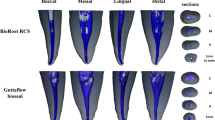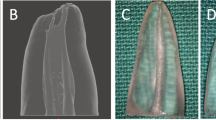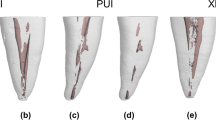Abstract
Objectives
The aim of the present study was to analyze the formation of voids and gaps in root canals obturated with different sealer materials in combination with warm gutta-percha vertical compaction technique by using BeeFill® 2in1.
Materials and methods
Twenty-four single-rooted teeth were collected, and root canals were prepared by using rotary files. All teeth were randomly allocated into three groups. Each group was obturated by using the BeeFill® 2in1 system in combination with Sealapex (non-eugenol, calcium hydroxide polymeric root canal sealer; Kerr Sybron, USA), RoekoSeal (polydimethylsiloxane-based sealer; Roeko, Germany), or 2Seal (epoxy-amine resin-based sealer; VDW, Germany). Following preparation, all teeth were scanned with a micro-computed tomography (CT) scanner, and a three-dimensional reconstruction of the obturated root canals was performed to analyze the volume of interface voids and gaps in the obturated teeth.
Results
Statistical analysis demonstrated that the silicon-based sealer RoekoSeal induced significantly less voids and gaps than other tested materials. The amount of voids and gaps significantly was higher in the apical region.
Conclusions
These data indicate that none of the root canal-filled teeth were free of gaps. Teeth obturated with RoekoSeal demonstrated to have the highest quality in terms of voids and gaps formation in combination with the BeeFill® 2in1 obturation system.
Clinical relevance
These findings point to the potential benefit of micro-CT analyses for in vitro evaluation of root canal obturation systems and provide further information about sealer materials used in combination with a warm gutta-percha vertical compaction technique.




Similar content being viewed by others
References
Sundqvist G, Figdor D, Persson S et al (1998) Microbiologic analysis of teeth with failed endodontic treatment and the outcome of conservative re-treatment. Oral Surg Oral Med Oral Pathol Oral Radiol Endod 85:86–93
Barthel CR, Moshonov J, Shuping G et al (1999) Bacterial leakage versus dye leakage in obturated root canals. Int Endod J 32:370–375
van der Sluis LW, Wu MK, Wesselink PR (2005) An evaluation of the quality of root fillings in mandibular incisors and maxillary and mandibular canines using different methodologies. J Dent 33:683–688
Liang YH, Yuan M, Li G et al (2012) The ability of cone-beam computed tomography to detect simulated buccal and lingual recesses in root canals. Int Endod J 45:724–729
Wilson NH, Christensen GJ, Cheung SW et al (2004) Contemporary dental practice in the UK: aspects of direct restorations, endodontics and bleaching. Br Dent J 197:753–756
Akman S, Akman M, Eskitascioglu G et al (2012) The use of endodontically treated and/or fiber post-retained teeth as abutments for fixed partial dentures. Clin Oral Investig 16:1485–1491
Bodrumlu E, Tunga U (2007) Coronal sealing ability of a new root canal filling material. J Can Dent Assoc 73:623
Bodrumlu E, Tunga U (2007) The apical sealing ability of a new root canal filling material. Am J Dent 20:295–298
Epley SR, Fleischman J, Hartwell G et al (2006) Completeness of root canal obturations: Epiphany techniques versus gutta-percha techniques. J Endod 32:541–544
Michaud RA, Burgess J, Barfield RD et al (2008) Volumetric expansion of gutta-percha in contact with eugenol. J Endod 34:1528–1532
Ozok AR, van der Sluis LW, Wu MK et al (2008) Sealing ability of a new polydimethylsiloxane-based root canal filling material. J Endod 34:204–207
Silver GK, Love RM, Purton DG (1999) Comparison of two vertical condensation obturation techniques: Touch 'n Heat modified and System B. Int Endod J 32:287–295
Schilder H (2006) Filling root canals in three dimensions. 1967. J Endod 32:281–290
Souza EM, Wu MK, van der Sluis LW et al (2009) Effect of filling technique and root canal area on the percentage of gutta-percha in laterally compacted root fillings. Int Endod J 42:719–726
Pagavino G, Giachetti L, Nieri M et al (2006) The percentage of gutta-percha-filled area in simulated curved canals when filled using Endo Twinn, a new heat device source. Int Endod J 39:610–615
Hammad M, Qualtrough A, Silikas N (2009) Evaluation of root canal obturation: a three-dimensional in vitro study. J Endod 35:541–544
Zogheib C, Naaman A, Medioni E et al (2011) Influence of apical taper on the quality of thermoplasticized root fillings assessed by micro-computed tomography. Clin Oral Investig
Wu MK, de Schwartz FB, van der Sluis LW et al (2001) The quality of root fillings remaining in mandibular incisors after root-end cavity preparation. Int Endod J 34:613–619
Wu MK, Fan B, Wesselink PR (2000) Diminished leakage along root canals filled with gutta-percha without sealer over time: a laboratory study. Int Endod J 33:121–125
Gulsahi K, Cehreli ZC, Kuraner T et al (2007) Sealer area associated with cold lateral condensation of gutta-percha and warm coated carrier filling systems in canals prepared with various rotary NiTi systems. Int Endod J 40:275–281
Lea CS, Apicella MJ, Mines P et al (2005) Comparison of the obturation density of cold lateral compaction versus warm vertical compaction using the continuous wave of condensation technique. J Endod 31:37–39
Ozawa T, Taha N, Messer HH (2009) A comparison of techniques for obturating oval-shaped root canals. Dent Mater J 28:290–294
Tortini D, Grassi M, Re Cecconi D et al (2011) Warm gutta-percha obturation technique: a critical review. Minerva Stomatol 60:35–50
Chohayeb AA, Tom C (1995) Comparison of thermoplasticized gutta-percha root canal obturation technique to the lateral condensation. NDA J 46:18–21
Farzaneh M, Abitbol S, Lawrence HP et al (2004) Treatment outcome in endodontics—the Toronto Study. Phase II: initial treatment. J Endod 30:302–309
Goldberg F, Artaza LP, De Silvio A (2001) Effectiveness of different obturation techniques in the filling of simulated lateral canals. J Endod 27:362–364
Cathro PR, Love RM (2003) Comparison of MicroSeal and System B/Obtura II obturation techniques. Int Endod J 36:876–882
Kececi AD, Unal GC, Sen BH (2005) Comparison of cold lateral compaction and continuous wave of obturation techniques following manual or rotary instrumentation. Int Endod J 38:381–388
Robberecht L, Colard T, Claisse-Crinquette A (2012) Qualitative evaluation of two endodontic obturation techniques: tapered single-cone method versus warm vertical condensation and injection system: an in vitro study. J Oral Sci 54:99–104
Gandolfi MG, Parrilli AP, Fini M et al (2012) 3D micro-CT analysis of the interface voids associated with Thermafil root fillings used with AH Plus or a flowable MTA sealer. Int Endod (in press)
Mirfendereski M, Roth K, Fan B et al (2009) Technique acquisition in the use of two thermoplasticized root filling methods by inexperienced dental students: a microcomputed tomography analysis. J Endod 35:1512–1517
Kazemi RB, Safavi KE, Spangberg LS (1993) Dimensional changes of endodontic sealers. Oral Surg Oral Med Oral Pathol 76:766–771
Caicedo R, von Fraunhofer JA (1988) The properties of endodontic sealer cements. J Endod 14:527–534
Dandakis C, Kaliva M, Lambrianidis T et al (2005) An in vitro comparison of the sealing ability of three endodontic sealers used in canals with iatrogenic enlargement of the apical constriction. J Endod 31:190–193
Tronstad L, Barnett F, Flax M (1988) Solubility and biocompatibility of calcium hydroxide-containing root canal sealers. Endod Dent Traumatol 4:152–159
Hammad M, Qualtrough A, Silikas N (2008) Extended setting shrinkage behavior of endodontic sealers. J Endod 34:90–93
Kielbassa AM, Uchtmann H, Wrbas KT et al (2007) In vitro study assessing apical leakage of sealer-only backfills in root canals of primary teeth. J Dent 35:607–613
Donnelly A, Sword J, Nishitani Y et al (2007) Water sorption and solubility of methacrylate resin-based root canal sealers. J Endod 33:990–994
Oliver CM, Abbott PV (2001) Correlation between clinical success and apical dye penetration. Int Endod J 34:637–644
Huumonen S, Kvist T, Grondahl K et al (2006) Diagnostic value of computed tomography in re-treatment of root fillings in maxillary molars. Int Endod J 39:827–833
Jung M, Lommel D, Klimek J (2005) The imaging of root canal obturation using micro-CT. Int Endod J 38:617–626
Hammad M, Qualtrough A, Silikas N (2008) Three-dimensional evaluation of effectiveness of hand and rotary instrumentation for retreatment of canals filled with different materials. J Endod 34:1370–1373
Liu N, Li X, Ye L et al (2012) A micro-computed tomography study of the root canal morphology of the mandibular first premolar in a population from southwestern China. Clin Oral Investig (in press)
Acknowledgments
The authors thank Mrs. B. Schiermeyer and Mrs. A. Weber for their skilled technical assistance, Mrs. Orzel for revising the manuscript, and the Medical Faculty of the University of Bonn for funding our research project.
Conflict of interest
The authors declare that they have no conflict of interest.
Author information
Authors and Affiliations
Corresponding author
Rights and permissions
About this article
Cite this article
Wolf, M., Küpper, K., Reimann, S. et al. 3D analyses of interface voids in root canals filled with different sealer materials in combination with warm gutta-percha technique. Clin Oral Invest 18, 155–161 (2014). https://doi.org/10.1007/s00784-013-0970-y
Received:
Accepted:
Published:
Issue Date:
DOI: https://doi.org/10.1007/s00784-013-0970-y




